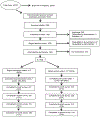Evaluation of Sex Positive! A Video eHealth Intervention for Men Living with HIV
- PMID: 31011912
- PMCID: PMC6803061
- DOI: 10.1007/s10461-019-02498-5
Evaluation of Sex Positive! A Video eHealth Intervention for Men Living with HIV
Abstract
Sex Positive![+] is a two-arm, video-based web intervention aimed at reducing condomless anal sex (CAS) with partners of known and unknown serostatus that was delivered online to a racially and ethnically diverse sample of 830 gay, bisexual, and other men who have sex with men living with HIV. Men in each arm received 6 weekly videos after completing a baseline assessment and 4 weekly booster videos following a 6-month assessment. Follow-up assessments were conducted every 3 months for 1 year. At 3-month follow-up, men in the intervention arm reported significantly reduced risk of having unknown serodiscordant CAS partners than men in the control arm (RR 0.60, 95% CI 0.39-0.92), partially supporting study hypotheses. Aside from this finding, similar reductions in sexual risk behaviors were observed in both arms over the study period. There is much to be learned about video-based web interventions in terms of methodological development and intervention delivery, including frequency and duration of intervention components.
Sex Positive! [+] es una intervención vía web de dos brazos basado en videos diseñados para reducir el sexo anal sin condón (SASC) con parejas de estado serológico conocido y desconocido. Los videos se distribuyeron vía Internet a una muestra racial y étnicamente diversa de 830 hombres homosexuales, bisexuales y otros hombres que tienen sexo con hombres que viven con VIH. Después de completar una evaluación basal, semanalmente se presentó un video a los hombres de cada brazo durante 6 semanas. Comenzando en el sexto mes, un video de refuerzo se presentó semanalmente durante 4 semanas. Las evaluaciones de seguimiento se realizaron cada tres meses durante un año. A los 3 meses de seguimiento, los hombres en el brazo de intervención reportaron una reducción significativa en el riesgo de tener SASC con parejas de estado serológico desconocido comparados con hombres en el brazo de control (RR = 0,60; IC del 95%: 0,39–0,92), lo cual apoya parcialmente la hipótesis del estudio. Además de este hallazgo, se observaron reducciones similares en las conductas de riesgo sexual en ambos brazos durante el período de estudio. Aún hay mucho que aprender acerca de las intervenciones con videos administradas por medio del Internet, específicamente en términos de desarrollo metodológico y modos de implementación, incluyendo la frecuencia y la duración de los componentes de la intervención.
Keywords: HIV; Intervention; MSM; Video; eHealth.
Conflict of interest statement
Figures



References
-
- Centers for Disease Control and Prevention. HIV surveillance report, 2017 November 2018.
-
- Hall HI, Holtgrave DR, Tang T, Rhodes P. HIV transmission in the United States: considerations of viral load, risk behavior, and health disparities. AIDS Behav. 2013;17(5):1632–6. - PubMed
MeSH terms
Grants and funding
LinkOut - more resources
Full Text Sources
Medical

